Alsace
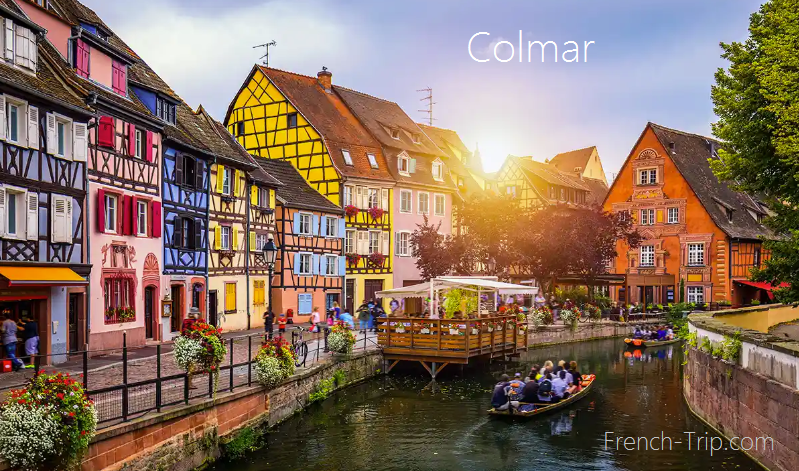
Nestled in the heart of Europe, Alsace is a captivating region in northeastern France that seamlessly blends French and German influences. This enchanting land is renowned for its picturesque villages with half-timbered houses, rolling vineyards producing world-class wines, and a rich cultural heritage that spans centuries. From the stunning Vosges Mountains to the meandering Rhine River, Alsace offers a diverse landscape that beckons travelers to explore its natural beauty and charming towns.
Visitors to Alsace can immerse themselves in a unique fusion of cultures, evident in the region’s architecture, cuisine, and traditions. The capital, Strasbourg, with its magnificent Gothic cathedral and quaint Petite France district, exemplifies this blend of influences. Meanwhile, the famous Alsace Wine Route winds through postcard-perfect villages like Colmar, Riquewihr, and Eguisheim, inviting wine enthusiasts and history buffs alike to savor the flavors and stories of this remarkable region. Whether you’re drawn to its Christmas markets, outdoor adventures, or gastronomic delights, Alsace promises an unforgettable journey through one of France’s most distinctive and alluring destinations.
What to visit:
- Barr — the wine capital of the Bas-Rhin department
- Bergheim — a charming village with beautiful fountains
- Cernay — stork park, some historical architecture, and vineyards entirely classified as Grand Cru
- Château du Haut-Koenigsbourg — the most beautiful castle in Alsace
- Châtenois — known for its medieval festival
- Colmar — possibly the most beautiful town in Alsace
- Eguisheim (Plus Beaux Villages de France)
- Guebwiller — 4 Grand Cru, significant Romanesque church
- Haguenau — Maginot Line
- Hunawihr (Plus Beaux Villages de France)
- Hunspach (Plus Beaux Villages de France)
- Katzenthal — castle ruins and its own Grand Cru
- Kaysersberg — a picturesque town with an important Romanesque church
- Mittelbergheim (Plus Beaux Villages de France)
- Mulhouse — huge car museum, the largest in Europe
- Munster — the birthplace of Munster cheese, abbey ruins
- Murbach — Romanesque abbey
- Neuf-Brisach — Vauban citadel — UNESCO
- Obernai — one of the most beautiful towns in Alsace
- Riquewihr (Plus Beaux Villages de France) — one of the two most popular and beautiful villages in Alsace
- Ribeauvillé — one of the most beautiful towns in Alsace with the ruins of three castles above it
- Rouffach — historic houses and the medieval “Witch Festival”
- Route des Vins d’Alsace — wine route
- Soultz-Haut-Rhin — 4 Grand Cru, birthplace of Dantes
- Sélestat — a city rich in architecture
- Strasbourg — historical center — UNESCO
- Thann — a beautiful Gothic cathedral and its own Grand Cru
- Turckheim — a picturesque town with its own Grand Cru
- Wissembourg — (Plus Beaux Villages de France)
Alsace travel guide
Alsace, located in northeastern France, is a picturesque and culturally rich region that offers a wide range of attractions for tourists. From charming medieval towns and vineyard-covered hills to historic landmarks and a unique blend of French and German influences, Alsace has something to offer every type of traveler.

Alsasian language
Alsace has changed nationality several times throughout history, shifting between France and Germany. During World War II, Hitler reclaimed Alsace (which had been annexed by France after Germany’s defeat in World War I), and it is quite shocking to see photographs from that time with Nazi flags hanging in the streets.
The suppression of local culture led to the Francization of Alsace (and Colmar along with it). However, you will still hear a lot of German spoken in Colmar, partly due to the many tourists from neighboring Germany and Switzerland, but also because of the native Alsatians who speak their German dialect, known as Alsatian. Alsatian is a minority language that is currently endangered, with fewer speakers among the younger generations. While Alsatian is not identical to standard German, it is somewhat mutually intelligible. For those familiar with German, Alsatian appears as a sort of pidgin German: recognizable words written in a simplified form, as if transcribed as heard.
In some parts of the city, as well as in Strasbourg, road signs are written in French, with Alsatian German underneath. Among the minority languages in France, Alsatian German is currently the most thriving (followed by Breton, Occitan, Basque, and Catalan), and many Alsatians will be pleased if you address them in German rather than French (though not everyone will). If you do not speak French, German will generally be your best choice. Unfortunately, English is not as widely spoken, but people are generally quite tolerant of English, and many locals will make an effort to communicate despite the language barrier.
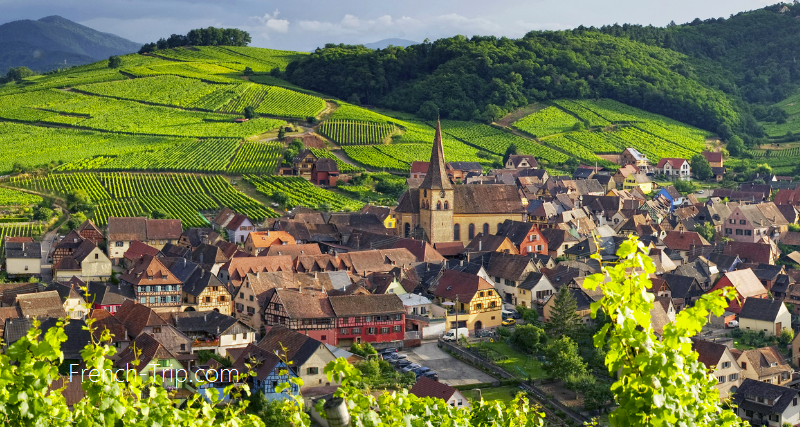
Alsace overview
Strasbourg
As the capital of Alsace and a UNESCO World Heritage site, Strasbourg is a must-visit destination. Highlights include:
- Strasbourg Cathedral (Cathédrale Notre-Dame): A stunning masterpiece of Gothic architecture.
- La Petite France: A picturesque neighborhood with half-timbered houses, canals, and cobblestone streets.
- European Parliament: You can visit and tour the seat of the European Parliament.
- Strasbourg Christmas Market: One of Europe’s most famous Christmas markets, known for its festive atmosphere and delicious food.

Colmar
Known as the “Little Venice” of Alsace, Colmar is a charming town famous for its well-preserved medieval and Renaissance buildings. Key attractions include:
- The Unterlinden Museum: Home to the Isenheim Altarpiece and a collection of art and artifacts.
- La Petite Venise: A picturesque canal district with colorful houses.
- Bartholdi Museum: Dedicated to the creator of the Statue of Liberty, Frédéric Auguste Bartholdi.
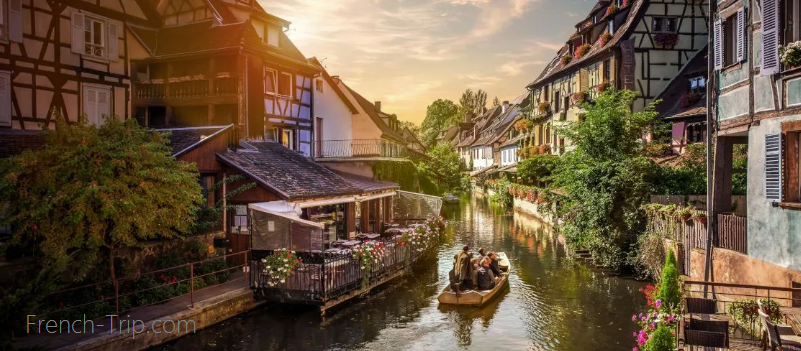
Wine Route (Route des Vins d’Alsace)
Alsace is renowned for its vineyards, and the Wine Route takes you through picturesque villages and vineyard-covered hills. You can visit wineries for tastings and explore charming towns like Riquewihr, Eguisheim, and Kaysersberg.
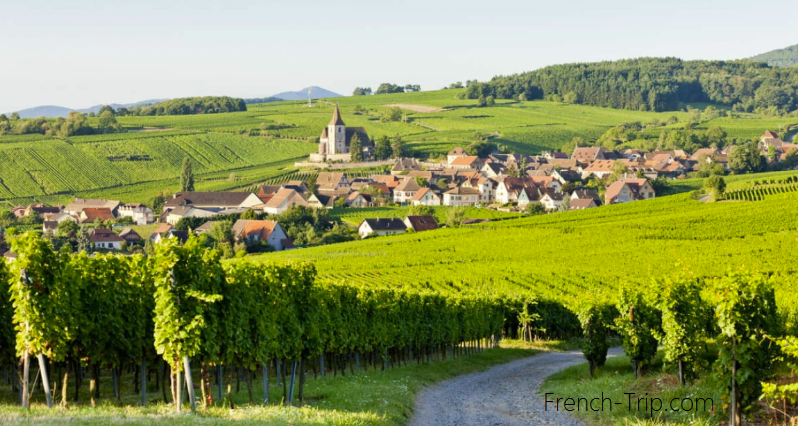
Châteaux
Alsace is dotted with beautiful castles and châteaux, including the Haut-Koenigsbourg Castle, which offers panoramic views of the region.
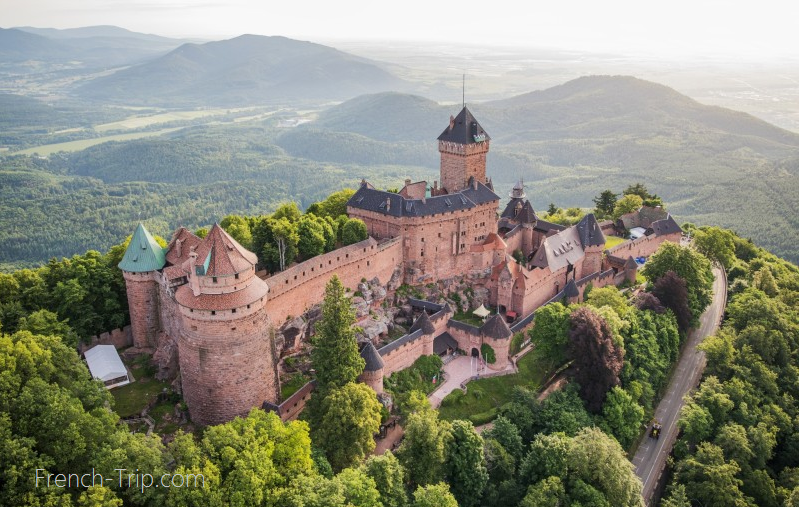
Cuisine
Alsace is famous for its culinary delights. Don’t miss the chance to savor dishes like choucroute (sauerkraut with sausages and other meats), tarte flambée (similar to pizza), and delicious Alsatian wines, including Riesling and Gewürztraminer.
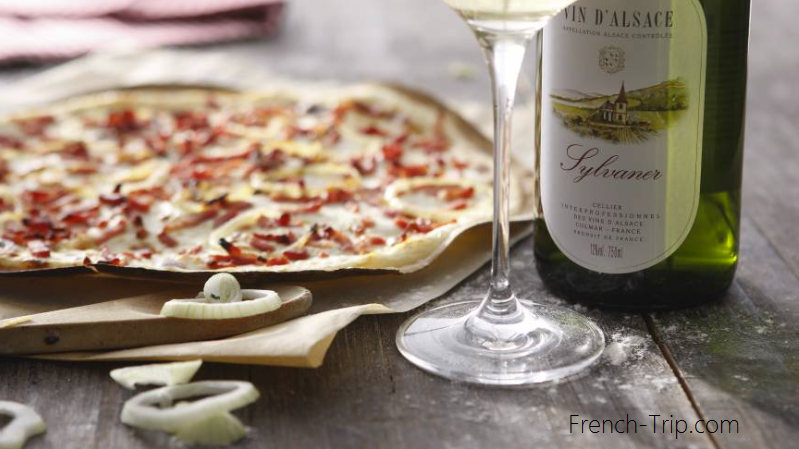
Outdoor Activities
The Vosges Mountains provide opportunities for hiking, skiing, and enjoying the natural beauty of the region. The region’s diverse landscapes include forests, lakes, and rolling hills.
Historical and Cultural Sites
Explore historic towns like Obernai, Mulhouse, and Sélestat, each with its unique character and heritage. Alsace also has a rich cultural scene with festivals, music events, and museums.
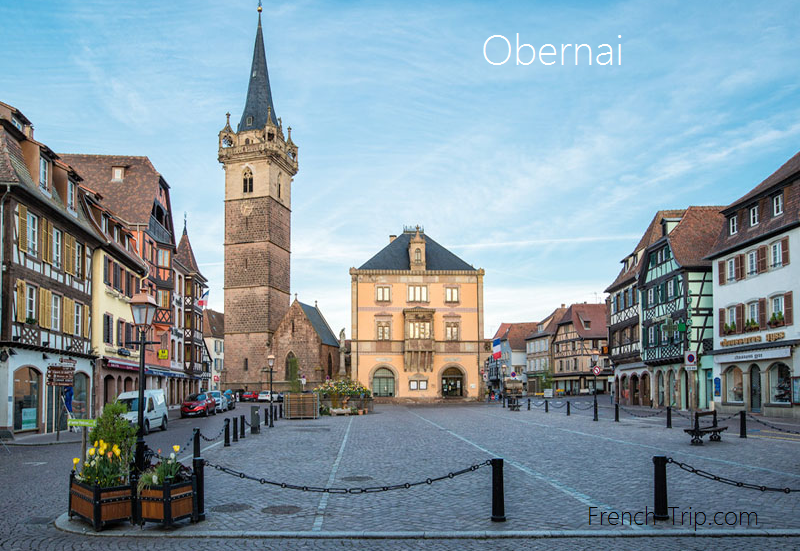
Christmas Markets
Apart from Strasbourg, other towns in Alsace, like Colmar and Mulhouse, host enchanting Christmas markets during the holiday season.

Alsace main sights
Alsace, located in northeastern France, is a region known for its picturesque villages, vineyard-covered hills, and a blend of French and Germanic culture. Here are some of the main sights and attractions in Alsace:
- Strasbourg: The capital of Alsace and the seat of the European Parliament, Strasbourg boasts a stunning old town (la Petite France) with half-timbered houses, the magnificent Strasbourg Cathedral (Cathédrale Notre-Dame), and the charming district of La Krutenau. The city is also famous for its Christmas markets.
- Colmar: Often called the “Little Venice” of Alsace, Colmar is a beautifully preserved town with winding canals, colorful houses, and cobblestone streets. The Unterlinden Museum, home to the Isenheim Altarpiece, is a must-visit.
- Riquewihr: This medieval village is a true gem, surrounded by vineyards and known for its well-preserved half-timbered houses. It’s often considered one of the most beautiful villages in France.
- Eguisheim: Another picturesque village, Eguisheim features concentric, flower-lined streets, and a charming central square. It’s a great place to explore on foot.
- Alsace Wine Route (Route des Vins d’Alsace): This scenic route winds through vineyard-covered hills, passing through charming villages and offering opportunities to taste some of Alsace’s finest wines. Make stops in villages like Kaysersberg and Obernai.
- Haut-Koenigsbourg Castle (Château du Haut-Koenigsbourg): This beautifully restored medieval castle offers panoramic views of the region and provides insights into the area’s history and defenses.
- Mulhouse: Known for its museums, including the Cité de l’Automobile, the largest automobile museum in the world, and the Cité du Train, a railway museum.
- Mont Sainte-Odile: This pilgrimage site features a convent, a church, and a panoramic viewpoint overlooking the Alsace Plain.
- Hiking and Nature: Alsace offers beautiful natural landscapes, including the Vosges Mountains. Explore the area’s hiking trails, such as those in the Ballons des Vosges Regional Nature Park.
- Christmas Markets: Alsace is famous for its enchanting Christmas markets, with Strasbourg hosting one of the oldest and most renowned in Europe.
These are just some of the main sights and attractions in Alsace. The region’s blend of natural beauty, historic charm, and culinary delights, including Alsatian cuisine and wines, make it a delightful destination for travelers.
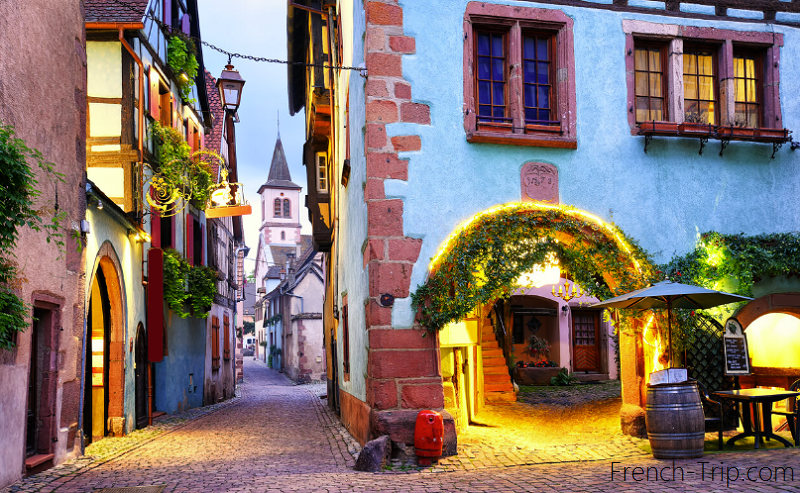
Places to visit in Alsace
Alsace is known for its picturesque villages and towns, each with its own unique charm and attractions. Here is a list of some of the villages and towns in Alsace that are worth visiting by tourists:
- Strasbourg: The capital of Alsace and a city with a rich blend of French and Germanic culture. Explore its stunning old town, Strasbourg Cathedral, and the picturesque district of La Petite France.
- Colmar: Often referred to as the “Little Venice” of Alsace, Colmar is known for its beautiful canals, colorful half-timbered houses, and excellent museums.
- Riquewihr: A perfectly preserved medieval village surrounded by vineyards. It’s one of the most beautiful villages in France and offers a step back in time.
- Eguisheim: A charming village with concentric, flower-lined streets and a central square. It’s known for its medieval architecture and ambiance.
- Kaysersberg: This small town is home to a beautifully restored historic center, the Albert Schweitzer Museum, and stunning views from the ruins of Kaysersberg Castle.
- Obernai: A quaint town known for its colorful buildings, charming streets, and the Saint-Odile Fountain. It’s a great place for a leisurely stroll.
- Mulhouse: Known for its museums, including the Cité de l’Automobile and the Cité du Train, which showcase the history of automobiles and trains.
- Hunawihr: A tiny village surrounded by vineyards and known for its fortified church and a stork park where you can observe these magnificent birds up close.
- Thann: This historic town features the Collégiale Saint-Thiébaut, a stunning Gothic church, and a picturesque old town.
- Bergheim: A fortified medieval village with well-preserved town walls and towers. It’s known for its historical charm and quaint streets.
- Sélestat: Explore the town’s historic center, featuring the Sainte-Foy Church and the Humanist Library, which houses valuable manuscripts.
When to visit Alsace?
Alsace experiences a semi-continental climate characterized by distinct seasons, with cold winters and warm summers. The region’s location in northeastern France, near the Vosges Mountains, also influences its climate.
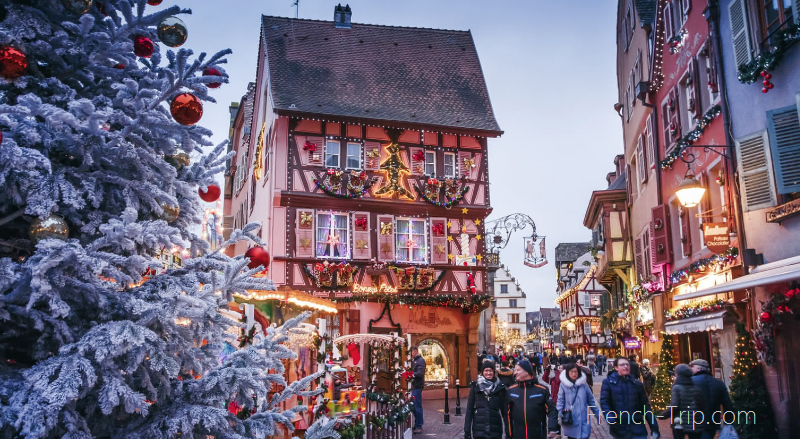
Here’s an overview of the climate in Alsace and the best times to visit:
Climate in Alsace:
- Spring (March to May): Spring in Alsace is generally mild, with temperatures gradually warming up. It’s a pleasant time to visit, as flowers bloom, and the vineyards start to come to life.
- Summer (June to August): Summers are warm to hot, with plenty of sunshine. July and August are the warmest months, and it’s a popular time for tourists. Outdoor activities, wine tasting, and festivals are in full swing during this season.
- Autumn (September to November): Autumn is a beautiful time to visit Alsace, especially for wine enthusiasts. The vineyards turn golden, and the weather is typically pleasant. September and early October are particularly ideal for enjoying the harvest season.
- Winter (December to February): Winters in Alsace are cold, with temperatures often dropping below freezing. Snowfall is not uncommon, especially in higher elevations. Christmas markets and the charming winter atmosphere attract visitors during this season.
Best Time to Visit:
- Late Spring (May and early June): This is a fantastic time to visit Alsace when the weather is mild, and the landscape is vibrant with blossoms and greenery. You’ll also avoid the peak summer crowds.
- Early Autumn (September and early October): Alsace’s vineyards come alive with colors during the grape harvest season. The weather is pleasant for outdoor activities, and it’s an ideal time to explore the villages and countryside.
- Christmas Season (late November to December): If you’re interested in experiencing the region’s famous Christmas markets and festive atmosphere, visiting during the holiday season can be magical. The towns and villages are beautifully decorated.
- Avoiding Peak Summer (June to August): While summer is a popular time to visit, it can also be crowded, especially in tourist hotspots like Riquewihr, Strasbourg and Colmar. If you prefer a quieter experience, consider traveling in May or September.
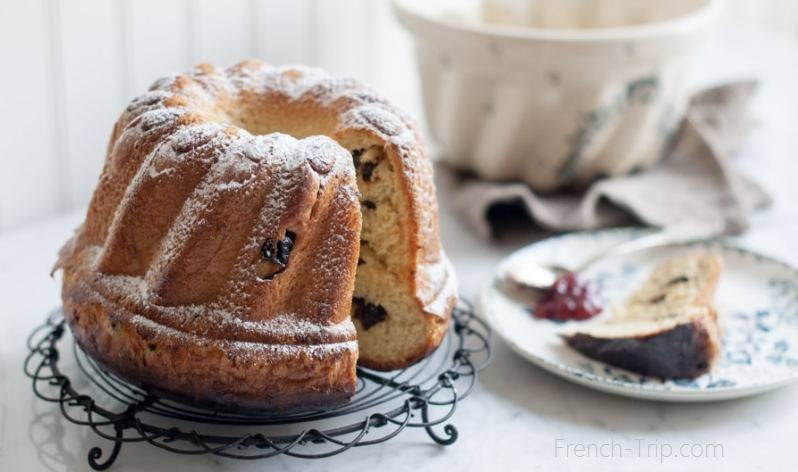
Alsace Cuisine and specialities
Alsace cuisine is a delightful fusion of French and German culinary traditions, reflecting the region’s rich history and cultural diversity. The most popular dishes include:
- Tarte Flambée (Flammekueche): A thin, crispy flatbread topped with cream, onions, and bacon. It’s often compared to pizza and is a popular Alsatian dish.
- Choucroute Garnie: Sauerkraut served with various sausages, smoked meats, and often accompanied by boiled potatoes. It’s a hearty and flavorful dish.
- Baeckeoffe: A slow-cooked casserole made with a combination of marinated meats (typically beef, pork, and lamb), potatoes, onions, and aromatic herbs.
- Coq au Riesling: A variation of the classic Coq au Vin, where chicken is cooked in white wine, often Riesling, and served with mushrooms and creamy sauce.
- Kugelhopf: A traditional Alsatian cake, typically flavored with almonds and often baked in a decorative, ring-shaped mold. It’s a popular dessert or breakfast treat.
- Alsace Wines: Alsace is renowned for its white wines, including Riesling, Gewürztraminer, and Pinot Gris. These wines complement the regional cuisine perfectly.
- Munster Cheese: A strong-smelling, soft cheese made from cow’s milk. It’s often enjoyed with bread or incorporated into dishes like tarte flambée.
- Alsace Pastries: The region is known for its delectable pastries, including fruit tarts, éclairs, and macarons, which are widely available in patisseries.
- Gingerbread (Lebkuchen): A sweet and spicy gingerbread often decorated with icing. It’s a popular treat during the Christmas season.
- Mirabelle Plums: These sweet plums are used to make various Alsatian desserts, including tarts and brandies.
- Beer: While wine is dominant, Alsace also produces its beer, often enjoyed alongside hearty Alsatian dishes.
Alsace cuisine is a blend of hearty, comforting dishes and delicate pastries, making it a diverse and flavorful culinary experience. The region’s wine culture and strong emphasis on local ingredients contribute to its unique gastronomic identity. More…
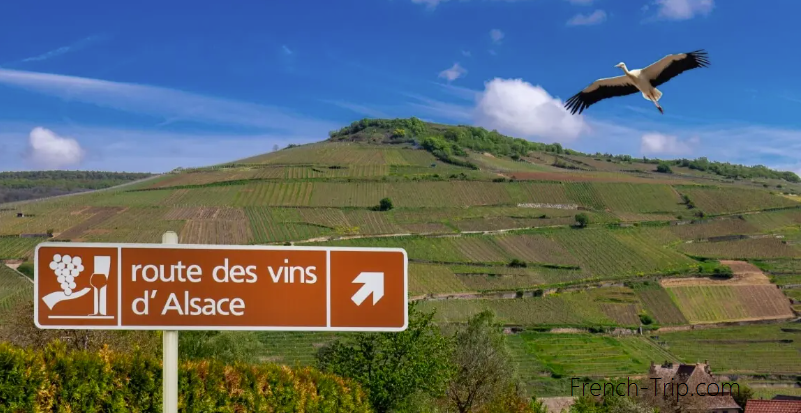
Alsace tourist routes
Alsace, known for its picturesque landscapes, charming villages, and rich culture, offers several tourist routes that allow visitors to explore the region’s diverse attractions and experiences. Here are some of the most notable tourist routes in Alsace:
- Alsace Wine Route (Route des Vins d’Alsace):
- This is one of the most famous tourist routes in Alsace, winding through vineyard-covered hills and showcasing the region’s renowned wine production. Visitors can explore wineries, picturesque villages, and sample exquisite Alsatian wines.
- Romanesque Route (Route Romane):
- This route takes you through a series of Romanesque-style churches and abbeys, each with its own unique architectural and historical significance. It’s a journey back in time to the Middle Ages.
- Alsace Villages Route (Route des Villages d’Alsace):
- Florival Valley Route (Route de la Vallée de la Florival):
- Explore the Florival Valley in the Vosges Mountains, known for its stunning natural beauty. The route takes you through picturesque landscapes, hiking trails, and the town of Guebwiller.
- Vosges Crest Route (Route des Crêtes):
- This scenic route offers breathtaking views of the Vosges Mountains and surrounding areas. It’s particularly popular for its hiking trails and panoramic viewpoints.
- Cycling Routes:
- Alsace is a paradise for cyclists, with dedicated cycling routes that wind through vineyards, forests, and charming villages. The routes cater to various skill levels and interests.
- Artists’ Route (Route des Artistes):
- This route connects the locations that inspired famous artists, including Gustave Doré, Auguste Bartholdi, and Jean-Jacques Waltz. It’s a journey through art and creativity.
- Castle Route (Route des Châteaux):
- Explore the historic castles of Alsace, such as Haut-Koenigsbourg Castle, along this route. It offers insights into the region’s medieval history and fortifications.
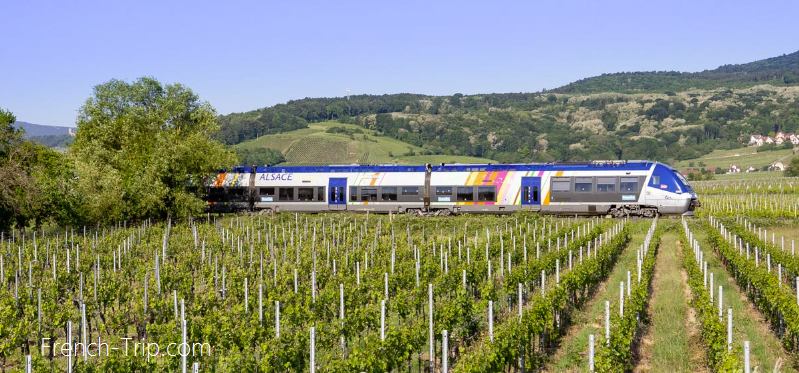
Alsace transport
Transportation in Alsace is generally convenient and efficient, making it relatively easy to explore the region, including the Alsace Wine Route. You have several options to choose from:
- Trains: The Alsace region is well-connected by the French railway system (SNCF). Major cities like Strasbourg, Colmar, and Mulhouse have train stations, providing easy access to the region. Train travel is comfortable and offers scenic views of the countryside.
- Tram and Buses: Strasbourg and Mulhouse have tram systems, while cities and towns in Alsace have bus networks. Strasbourg, in particular, has an extensive tram network that covers the city and surrounding areas.
- Tourist Buses: available only in high season along Wine route (KUT’ZIG)
- Car Rental: If you plan to explore the Alsace Wine Route, renting a car can be a convenient option. This allows you to visit the charming villages and vineyards at your own pace. Many car rental agencies are available at airports and in major cities.
- Cycling: Alsace is known for its cycling-friendly infrastructure. You can rent bicycles in several towns and explore the wine route and scenic countryside on dedicated cycling paths.
- Taxis and Ride-Sharing: Taxis are readily available in major cities, and ride-sharing services like Uber are also operational in certain areas.
- Boat Cruises: Along the Rhine River, you can find boat cruises that offer scenic journeys with beautiful views of Alsace. Some cruises include guided tours and wine tastings.
- Tourist Transportation: In some areas, you can find tourist transportation options such as tourist trains and wine-themed buses that take you along the wine route and to various wineries.
Regarding the Alsace Wine Route, it’s quite feasible to explore it using public transportation, especially if you’re staying in one of the larger towns like Strasbourg or Colmar. Trains and buses connect these cities to smaller towns and villages along the route. Additionally, guided tours and organized excursions that include transportation are available if you prefer a hassle-free experience.
However, if you want the flexibility to visit multiple wineries and explore the smaller, off-the-beaten-path villages along the wine route, renting a car may be more convenient. It allows you to set your own schedule and stop wherever you please.
More about Transportation in Alsace
Archives
Calendar
| M | T | W | T | F | S | S |
|---|---|---|---|---|---|---|
| 1 | 2 | |||||
| 3 | 4 | 5 | 6 | 7 | 8 | 9 |
| 10 | 11 | 12 | 13 | 14 | 15 | 16 |
| 17 | 18 | 19 | 20 | 21 | 22 | 23 |
| 24 | 25 | 26 | 27 | 28 | 29 | 30 |